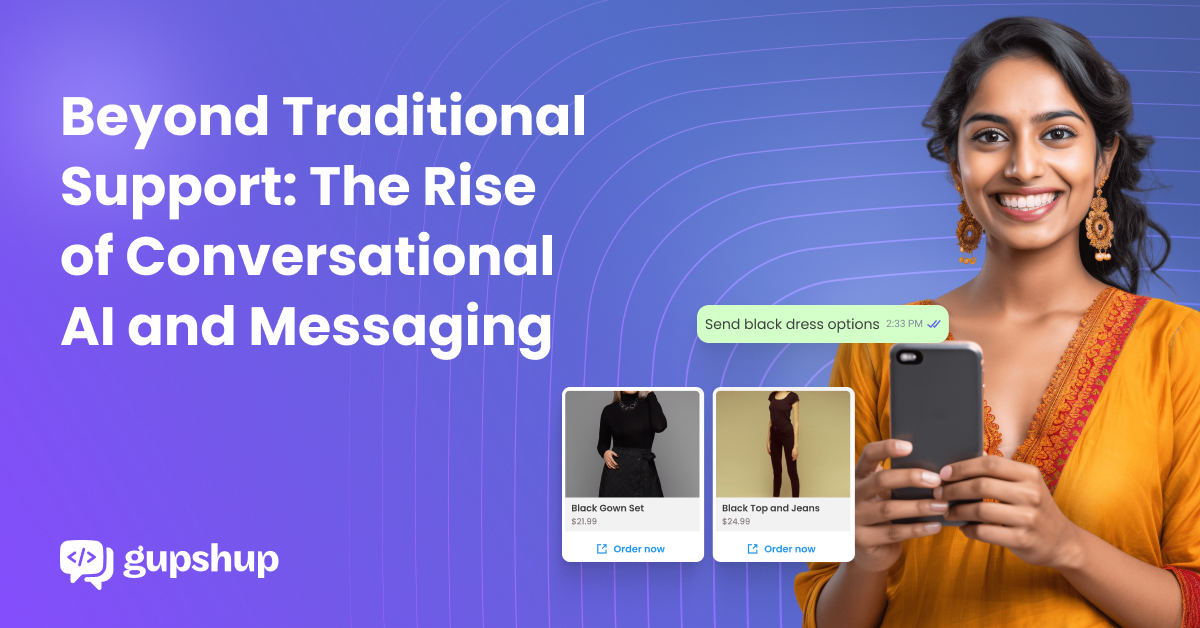Beyond Traditional Support: The Rise of Conversational AI and Messaging

The traditional customer service model is undergoing a significant transformation in today’s digital age. The emergence of conversational AI and AI powered chatbots has paved the way for a new era of customer interaction. This evolution raises an important question: Are call centers becoming obsolete, or are they simply transitioning into a more digital format? In this blog, we explore how businesses are moving beyond traditional call centers and native apps by leveraging conversational AI for business, ultimately enhancing customer support and engagement.
The Changing Landscape of Customer Service
Challenges with Traditional Call Centers:
For many, the thought of calling customer service is met with dread. Long wait times, complicated interactive voice response systems, and unsatisfactory interactions with agents are common grievances. Furthermore, a generational shift has seen a growing aversion to phone conversations, pushing businesses to rethink their customer service strategies. despite ongoing improvements in technology and processes.
Limitations of Email and Live Chat:
Recent trends indicate a declining preference for email, particularly among younger demographics like Gen Z, who often place it in the same undesirable category as phone calls. Website Live chat systems require users to remain active on a website, which can be impractical, leading to fallbacks on less preferred communication methods like email or phone calls to complete their service interactions. While native apps bypass some of these issues, engagement data shows that most users regularly use only a limited number of apps, and about 25% of downloaded apps are never used after the initial launch.
The Rise of Omnichannel Support:
In light of these shifts, proactive businesses have evolved. Call centers have transformed into omnichannel communication platforms. Conversational AI and AI powered chatbots are now common on websites, offering prompt and effective customer interactions. Support features are also increasingly embedded within many companies’ native mobile apps, though these solutions still present both social and functional challenges.
Advancements in Messaging Technology
Messaging as a Preferred Communication Channel:
The evolution of messaging technology has introduced new opportunities for customer engagement throughout their purchasing journey. Messaging apps remain among the most downloaded and utilized applications, and are becoming a preferred communication channel for consumers wishing to connect with businesses. These offer a more favored medium for customer-business interactions. A notable 2020 survey highlighted that 75% of participants preferred connecting with businesses through messaging apps over other channels.
Equipped with business-centric features like automation and APIs that integrate seamlessly with existing support systems, these platforms enable businesses to efficiently meet customers where they are, enhancing both engagement and satisfaction.
Messaging Apps With Benefits of Conversational AI:
Conversational AI and AI powered chatbots enable businesses to scale their customer service efforts effectively. These technologies facilitate seamless integration with existing support systems and offer automation capabilities that enhance the customer service experience across the buyer’s journey. The automation of routine inquiries allows customer service teams to focus on more complex issues that require a human touch.
Let’s explore how a messaging-based customer service experience measures up.
Comparison of Support Channels
Messaging vs. Traditional Phone-based Service

Conversational AI, including modern messaging systems and AI powered chatbots, provides a distinctly different experience from traditional phone-based customer service. Messaging is an asynchronous communication method, allowing the conversation to unfold on the customer’s schedule. If an agent isn’t available or a customer can’t respond immediately, there’s no need to call back and endure further waiting; the conversation simply resumes when possible. In contrast, phone-based service is a real-time, synchronous form of communication that often leaves customers on hold until an agent is available to assist them.
Messaging not only helps decrease wait times but also maintains a complete history of the interaction. This continuity reduces the need for customers to repeat information, a frequent issue with phone support. Moreover, messaging excels in the exchange of documents and media. Unlike phone conversations that might require supplementary systems like email or web platforms for sharing files, a robust messaging experience allows for the direct transfer of photos, videos, documents, and locations within the conversation itself. This integration minimizes disruptions caused by switching between apps and facilitates quicker resolution of issues.
Furthermore, with the integration of automated messaging solutions, businesses can efficiently address low-complexity inquiries through a self-service model, freeing up customer service agents to tackle more complex issues that necessitate a personal touch. This strategic use of conversational AI in the messaging channels for business enhances overall customer service efficiency and effectiveness.
Messaging vs Alternate Support Options

While email, on-site chat, and native apps each provide solutions to the limitations of traditional phone-based support, they come with their own set of drawbacks. Some issues are social—users may be hesitant to adopt these methods, or they may find the user experience lacking. Other challenges are technical, such as the need for real-time interactions with agents or the inability to resolve issues without switching platforms. Integrated with Conversational AI, the messaging apps can address both these social and technical hurdles effectively.
Conversational AI through messaging offers faster and more transparent communication than email. It eliminates the need for customers and support agents to navigate cluttered inboxes or manage complex email threads. This improvement is crucial, especially considering a 2021 survey which found that 62% of companies fail to respond to support emails, leading to customer neglect. Messaging empowers customers to initiate contact at their convenience on a platform they prefer, thus enhancing the likelihood of adoption. Customers are no longer required to keep a chat window active in their browsers or continuously engage with a native app.
What Does This All Mean for the Future of Customer Support?
Does this indicate a potential disappearance of contact centers or the removal of native apps from app stores? It’s unlikely. There are compelling reasons to continue supporting well-trained teams and maintaining the unique functionalities that native apps provide. Fortunately, modern messaging platforms such as WhatsApp, Messenger, and Instagram Direct offer business solutions that can enhance existing tools. Features like “click-to chat Ads” allow users to transition seamlessly from a website, app, or advertisement directly into a conversation. Additionally, APIs available on these platforms can be integrated with backend systems to create a comprehensive, rich conversational experience tailored to business needs.
Indeed, the adoption of messaging solutions is already underway in many organizations. A McKinsey study revealed that 77% of surveyed businesses have already developed digital platforms. However, only 12% have achieved a high level of integration with these systems. The key to transforming customer experience lies not just in adding new features but in tightly integrating these systems to leverage their full potential. For businesses looking to start or enhance their use of conversational AI for business, exploring how to integrate platforms like the WhatsApp Business API Platform can significantly improve service offerings.
Getting Started?
Learn more about initiating your journey with conversational AI.

Blogs you will want to share. Delivered to your inbox.
Business Email
Recommended Resources
Read: How Retailers Can Combine Gen-AI with Conversational Flows to Deliver Personal Customer Interactions?



